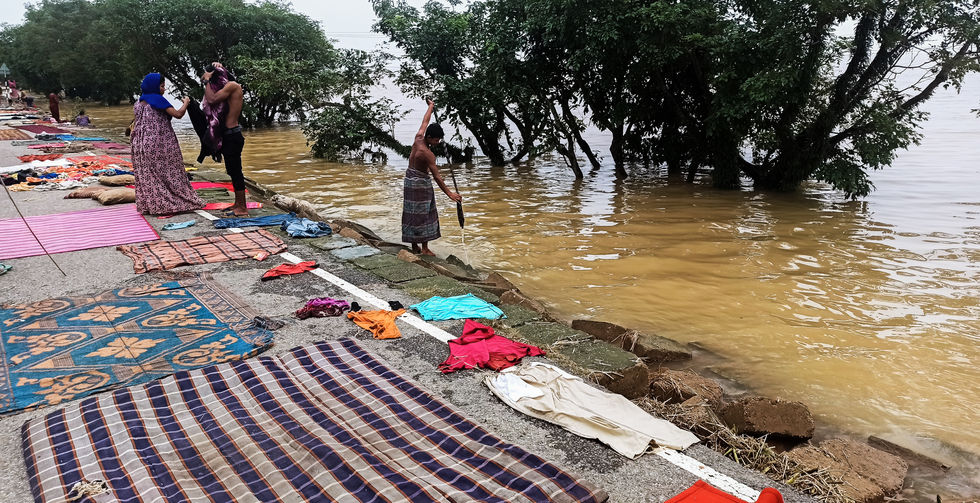
Courtesy of
Gourab Saha
Climate Change
Gourab Saha
Shahjalal University of Science and Technology
Sylhet
Bangladesh
Highly Commended
I am Gourab Saha. Currently, I am continuing my master’s degree in Geography and Environment at Shahjalal University of Science and Technology. I am a passionate photographer.
It was 2017 when I first started in photography. I loved to capture the exciting moment. I was roaming the street to take photographs. But, my photographic thinking and purpose were changed because of my educational background. As an environmental student, I got many opportunities to travel and explore nature, and at that time, I realised how we affect the environmental ecosystem. People in developing countries like Bangladesh are more unaware of environmental or sustainable development. So, for this reason, I have been doing environmental documentaries to make people aware of my photographs. Bangladesh is a very disaster-prone area for its geographical location; on the other hand the careless attitude of the people increases the speed of environmental degradation. As a result, disaster is more frequent now for this reason.
I have been working on flash floods in the Sylhet region for the last two years, and flash floods events to describe properly how climate change is happening and the anthropogenic effect of flash floods. Because of the high amount of deforestation in hilly areas, flash floods are more frequent and devastating in the Sylhet region. So, at the present time my main aim is to spread awareness among people about climate change and the importance of safe the environment through my photography.
Flash Flood: Hustle and Bustle
Tahirpur Upazila, Sunamganj District, Sylhet division, Bangladesh
2022
Flash floods are becoming a new normal in the northeastern region of Bangladesh. Within the last two months, Sylhet district has faced two flash floods, and they hit the Sunamganj district three times.
On June 16, 2022, the heavy rainfall started in the northeastern region, and specifically, the Meghalaya and Assam region were facing downpours. The wave of haor was deadly, and the airspeed was high. Rapidly the flood water was entering the northeastern region of Bangladesh (Sunamganj district). During the disaster, I was stuck in Tahirpur Upazila of Sunamganj district. Before this disastrous incident, I had never seen how fast the water level rose in such a short time. That night when the precipitation was heavy, we didn’t realize the intensity of the flood in the Sylhet region because there was no electricity, most of our mobile phones were dead, and the internet connection was unavailable. The very next morning, news started coming from the surrounding area that the flooding condition was getting worse.
Geographically, Tahirpur Upazila is situated in the foothills of the Meghalya Asam hill region and surrounded by Tangua Haor, Metir Haor, and Shonir Haor, which makes the Upazila one of the major hotspots for flooding. This Upazila lost road-based communication with Sunamganj and waterway communication turned into a death trap as water level and wave intensity increased continuously. So, I had to stay there for four days. I witnessed the devastation caused by flooding firsthand. Almost everyone took shelter in a school. Water was everywhere, and there was no dry place for animals or humans. The panic of the food crisis was spreading across the market. The majority of tubewells were submerged by flood water and the crisis of fresh drinking water was increasing. Local people started rainwater harvesting but the quantity was nothing compared to their necessity. So, they started using haor water for daily chores like drinking, showering, washing utensils, and sanitation which was detrimental to their health, but there was no alternative way available.
The area lost the electricity connection because the wire was submerged in haor water. I couldn’t charge my camera and mobile and couldn’t capture the whole scenario. There was a generator in the market, but it was insufficient compared to the local necessity to charge their electronic devices.
On the fourth day of the flood, the consistency of precipitation was getting lower, and the water level began to drop. I was sun rays though it was only for a few seconds! People were very optimistic there. They did not waste a moment putting full effort into returning to their usual life. They started catching fish, drying their clothes on the available dry street, and chatting to calm their minds.












